Marlborough Pub and Theatre
The Marlborough Pub and Theatre is a historic venue, situated at 4 Princes Street, Brighton. It has been associated, since the 1970s, with the LGBT community. The Marlborough's small theatre presents theatre, cabaret and music throughout the year, including during the Brighton Fringe Festival, LGBT History Month and Brighton Pride Arts Festival.
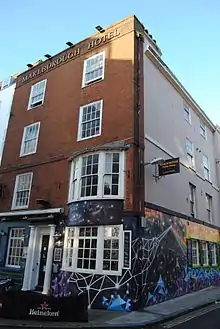
Early history
The Marlborough was built in 1787 as an inn called the Golden Cross. The cellar has a bricked-up passageway which, it is rumoured, provided a direct link between the inn and Royal Pavilion (left). According to Brighton lore, this was used by George, Prince of Wales to make discreet visits, either to a brothel[1] or a theatre[2] in the inn.
In the early 1820s, the inn was owned by James Ireland, a prosperous local woollen-draper and undertaker. Ireland also owned land on the Level where, on 1 May 1823, he opened his ‘Royal Gardens’ to the public. The pleasure gardens including a ladies’ bowling-green, an aviary, an ornamental grotto, a maze, and a small lake. Despite numerous attractions and special events, Ireland’s Gardens were not a financial success and he sold them in December 1826.[3]
During James Ireland’s tenure, the Brighton Royal Catch & Glee Club, a popular subscription music society, met at the Golden Cross every Tuesday evening.[4]
Ireland was succeeded at the Golden Cross by Robert Ellis and then, in the 1840s, by the brothers James and William Creech. In 1849, James Creech got into financial difficulties and, after borrowing money against the contents of the pub, all the property’s goods were seized and sold by the Sheriff of Sussex to pay Creech's creditors. Thanks to the subsequent debt collector's record,[5] we have a detailed description of the inn's interior and furnishings in 1849. The 20-room inn offered drink, food, lodgings and recreations to gentlemen of comfortable means. On the top floor were four bedrooms, furnished with Japanned (black lacquered) and mahogany bedsteads, dressing tables, wash stands and chests of drawers; white dimity, leather-covered armchairs; and Kidderminster or Brussels carpets. On the second floor were three slightly bigger rooms, with four-poster beds. On the first floor were four comfortable sitting rooms, with open fires, velvet-covered oak chairs and mahogany tables. The third sitting room had a piano in a mahogany case. The first floor also had a ballroom (where the current theatre is). Its fittings included a mahogany board for the game of Racehorse Balls and 20 brown ware spittoons. The ground floor featured the bar, plus a parlour (with 20 iron spittoons) and a coffee room, with a writing desk. The bar featured an 18 x 3 ft counter and a spirit fountain with eight brass taps. The kitchen was well equipped, with numerous pans, fish steamers and a five-foot kitchen range.
With the selling off of the fixtures and fittings, the building's life as a fashionable inn came to an end. It was now a typical Victorian pub, renamed the Marlborough Tavern (later Hotel) around 1850.[6] From the 1860s,the landlord was Thomas Packham. His son, also Thomas, succeeded him in 1885.
Murder at the Marlborough
In 1900, the Marlborough was the setting for a murder case, when Lucy Packham, wife of the landlord, was found dead and badly battered at the foot of the stairs. Her husband Thomas was arrested and tried for murder. At the trial, a policeman, PC Puttick, testified that, while in the street outside the pub on the day of the killing, he had heard Packham say to his wife, ‘You’re a lazy woman. You ought to be killed. I will kill you’. Despite this evidence, the all-male jury found Packham guilty only of manslaughter, sentencing him to just four years in prison. In 1979, the crime was re-enacted in the pub with a comic play, Murder at the Marlborough, by John Montgomery, starring Binky Baker. During the play, the audience watched the murder in the bar, and the trial in the theatre upstairs. According to John Rackham, the first performance was disrupted by a woman customer, who was unaware that a play was in progress:
On seeing the 'victim' crash to the floor after being 'hit' by a bottle, she burst into hysterical screams. Hardly had she been pacified with a hissed revelation of the truth when a new customer arrived at the pub. Surprised to see such a crush of people in the bar, he failed to notice the 'victim' still laid out on the floor, and promptly tumbled over her, to appreciative applause from those watching![7]
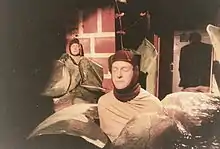
Ghost stories
Over the years, bar staff at the Marlborough have described poltergeist-like activities in the pub, which they blame on Lucy Packham's ghost. Eddie Scannell, landlord in the 1970s, recalled, 'It was around 1976 and soon after evening closing time. the bar staff had gone home and I'd locked all the doors and was clearing up the bar. Suddenly the temperature dropped and there was a cold draught. The next moment I felt something invisible brush past me. I was shocked enough to leave the rest of the bar work until the following morning!'.[7] In 2000, manager Sue Kerslake described witnessing lights going on and off, the switching off the gas on beer taps and the shattering a row of bottles, swept off a shelf behind the bar.[8] The pub is a major location on the Brighton Ghost Walk.
Sussex Gay Liberation Front
The pub's links with Brighton's LGBT community date from the 1970s. Sussex GLF (Gay Liberation Front), formed in February 1971 by Sussex University students, started to have regular meetings on Tuesdays at the Marlborough from early 1974, and discos were held fortnightly on Fridays. They held other events too, including a 1974 screening of a BBC documentary about gay Christians, The Lord is my Shepherd and He Knows I’m Gay. After Sussex GLF, came Brighton CHE (Campaign for Homosexual Equality) which took the Tuesday meeting slot from 1976 until 1981. In the 1970s, the pub was also being used for regular events for the local branch of the right wing National Front.
The Marlborough Theatre
The pub theatre, with a capacity of 50-60, dates from a refurbishment in the 1970s, with the building of a stage with a proscenium arch. There was a second refurbishment in 1988, with the addition of thick velvet curtains. On 4 March 1988, the venue re-opened as the New Marlborough Theatre.[9]
Siren Theatre Company
In 1979, Jude Winter, Tasha Fairbanks, Jane Boston and Deb Trethewy — previously members of Brighton-based bands The Devil’s Dykes and The Bright Girls — formed the radical lesbian feminist theatre collective, Siren. Siren’s shows included Curfew, Mama’s Gone a-Hunting, From The Divine…, Now Wash Your Hands, Pulp and Hotel Destiny. The company made their debut at the Marlborough and toured extensively until disbanding in 1989. They also released two albums, Siren Plays and In Queer Street.[10] Siren reformed in 2014, announcing plans to perform again at the Marlborough.
The content of Siren's work relates very explicitly to the position of women in our society: how women occupy different social positions according to our class, disabilities, race, creed and sexuality, and how struggles can be waged from these various points against the institutions of oppression. Having said this, we utterly refuse to be hived into the ghettoized category of 'women's theatre'....The questions we raise and the concepts we challenge have universal impact.[11]
John Roman Baker and Aids Positive Underground
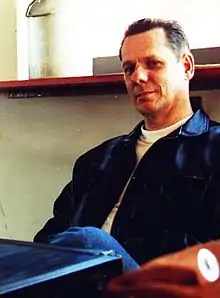
Another company linked with the Marlborough was Aids Positive Underground Theatre (now Aputheatre) which performed the In-yer-face theatre plays of John Roman Baker. The subject of these works was the impact of HIV and AIDS on gay men at the height of the crisis. The company's first play, Crying Celibate Tears, was such a success with critics and public in the 1989 Brighton Fringe Festival that they were selected to be part of the main Brighton Festival in 1990 with two shows, The Ice Pick and Stretching Frontiers. The first, which premiered at the Marlborough in May 1990, was described in the festival brochure as 'the second of a trilogy in which the profoundest commitment of men to each other is essential to their survival. Michael is HIV positive. Peter chooses not to know. Note: This production contains scenes which may offend.''.[12] Despite causing controversy, the play still won the festival's ‘Best Theatre’ award. Stretching Frontiers was an 'entertainment devised around travel and risk by John Roman Baker, with music by Michael Finnissy',[12] also staged at the Marlborough.
The Crying Celibate Tears trilogy was completed in 1991 with Freedom to Party, staged yet again at the Marlborough as part of the main Brighton Festival. This final play is set in an imagined future, years after a cure has wiped HIV from gay collective memory. 'The freedom to party, and to forget, has returned. But what of the survivors and the rejected?'[13]
Best LGBT Bar None Award
From 1997, the Marlborough, now a lesbian pub, was run by Sue Kerslake and Bernadette Moss. Kath Lawson was manager in October 2006, when the Marlborough won the ‘Best Bar None’ award for best LGBT Venue, sponsored by Pink News and 3Sixty magazine. Lesbian and gay venues that entered were assessed on a variety of aspects of the business, including public safety, the prevention of crime and disorder and protecting children from harm. 'We’re absolutely delighted with the award,' said Kath Lawson,'I’ve always tried to run the pub so it’s a safe and welcoming place for people to drink.'[14]
From 2003-5, the theatre was run separately from the pub, by Ros Barber and Paul Stones, who programmed a wide variety of theatre and comedy. It was then managed by Nicola Haydn and Eden Rivers (Otherplace Productions), who moved on, in 2009, to programme theatre in other Brighton venues.
The Maydays
In 2004, the award-winning improvised comedy troupe, The Maydays, made its debut at the Marlborough. Rebecca McMillan of the Maydays later recalled the show for Sussex Life magazine:
We did our very first performance here at the Marlborough in 2004. It went brilliantly. I'll never forget the feeling of getting my first laugh – I got bitten by the bug. Performing at the Marlborough always feels like coming home, it's got such a cosiness, intimacy and friendliness...It has a real old world charm – the plush curtains, the raised stage – things that so many small venues don't have.[1]
Pink Fringe

Since 2009, the theatre has been run by Marlborough Productions, now a not-for-profit community interest company led by Abby Butcher, David Sheppeard and Tarik Elmoutawakil.
External links
References
- Laura Kayne, Backstage Brighton, QueenSpark Books, 2010, p.20.
- Rose Collis, New Encyclopaedia of Brighton, Brighton & Hove City Council, 2010, p.356.
- Rose Collis, New Encyclopaedia of Brighton, Brighton & Hove City Council, 2010, p.158.
- The New Monthly Magazine, Vol.10, p45..
- AMS 66109/9/1-3, The Keep
- John Beard, Brighton and Hove Pubs Past and Present, JB Enterprise, 1998, p.9-10
- John Rackham, Brighton Ghosts and Hove Hauntings, Latimer Publications, 2001, p128-9
- Brighton Evening Argus, 30 October 2000
- Timothy Carder, The Encyclopedia of Brighton, East Sussex County Libraries, 1990, entry 189.l
- Tasha Fairbanks, Pulp and Other Plays, edited by Gabrielle Griffin and Elaine Aston, Routledge, 1997.
- Siren Policy Statement, 1986, quoted in Pulp and Other Plays, edited by Gabrielle Griffin and Elaine Aston, Routledge, 1997.
- Brighton Festival 1990 Brochure, p.12
- Brighton Festival 1991 Brochure, p.15
- 'Brighton breaks new ground with LGBT Best Bar None award winner.' Pink News, 2006
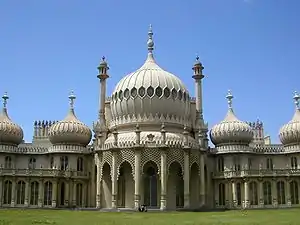
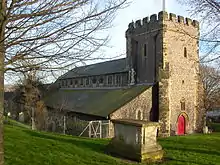
.jpg.webp)
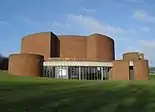

.jpg.webp)
